Coccidioidomycosis (Valley Fever), Soil Moisture, and El Nino Southern Oscillation in California and Arizona
Abstract
:1. Introduction
2. Materials and Methods
3. Results
3.1. Coccidioidomycosis Cases
3.2. Soil Moisture
4. Discussion
4.1. Modulation of SSM and RZSM by ENSO
4.2. Connection between ENSO and Coccidioidomycosis Cases
4.3. Issues with Coddidiodomycosis Case Numbers
4.4. Connection between Non-Climatic Factors and Coccidioidomycosis Cases
5. Conclusions
Author Contributions
Funding
Institutional Review Board Statement
Informed Consent Statement
Data Availability Statement
Conflicts of Interest
References
- Tamerius, J.D.; Comrie, A.C. Coccidioidomycosis incidence in Arizona predicted by seasonal precipitation. PLoS ONE 2011, 6, e21009. [Google Scholar]
- McCotter, O.Z.; Benedict, K.; Engelthaler, D.M.; Komatsu, K.; Lucas, K.D.; Mohle-Boetani, J.C.; Oltean, H.; Vugia, D.; Chiller, T.M.; Sondermeyer Cooksey, G.L.; et al. Update on the Epidemiology of coccidioidomycosis in the United States. Med. Mycol. 2019, 57 (Suppl. 1), S30–S40. [Google Scholar] [CrossRef] [PubMed]
- Centers for Disease Control and Prevention (2018) Valley Fever (Coccidioidomycosis) Statistics. Available online: https:www/cdc.gov/fungal/diseases/coccidioidomycosis/statistics.html (accessed on 19 January 2020).
- Shriber, J.; Conlon, K.C.; Benedict, K.; McCotter, O.Z.; Bell, J.E. Assessment of vulnerability to Coccidioidomycosis in Arizona and California. Int. J. Environ. Res. Public Health 2017, 14, 680. [Google Scholar] [CrossRef] [PubMed] [Green Version]
- Gorris, M.E.; Treseder, K.K.; Zender, C.S.; Randerson, J.T. Expansion of Coccidioidomycosis endemic regions in the United States in response to climate change. Geohealth 2019, 3, 308–327. [Google Scholar] [CrossRef] [PubMed] [Green Version]
- Gorris, M.E.; Cat, L.A.; Zender, C.S.; Treseder, K.K.; Randerson, J.T. Coccidioidomycosis dynamics in relation to climate in the southwestern United States. Geohealth 2018, 2, 6–24. [Google Scholar] [CrossRef]
- Weaver, E.A.; Kolivras, K.N. Investigating the relationship between climate and Valley Fever (Coccidioidomycosis). EcoHealth 2018, 15, 840–852. [Google Scholar] [CrossRef]
- Nguyen, C.; Barker, B.M.; Hoover, S.; Nix, D.E.; Ampel, N.M.; Frelinger, J.A.; Orbach, M.J.; Galgiani, J.N. Recent advances in our understanding of the environmental, epidemiological, immunological, and clinical dimensions of coccidioidomycosis. Clin. Microbiol. Rev. 2018, 26, 505–525. [Google Scholar] [CrossRef] [Green Version]
- Comrie, A.C. No consistent link between dust storms and Valley Fever (Coccidioidomycosis). Geohealth 2021, 5, e2021GH000504. [Google Scholar] [CrossRef]
- Coppersmith, E.J.; Bell, J.E.; Benedict, K.; Schriber, J.; McCootter, O.; Cosh, M.H. Relating Coccidioidomycosis (valley fever) incidence to soil moisture conditions. Geohealth 2017, 1, 51–63. [Google Scholar] [CrossRef]
- Stacy, P.K.R.; Comrie, A.C.; Yool, S.R. Modeling valley fever incidence in Arizona using a satellite-derived soil moisture proxy. GISci. Remote Sens. 2012, 49, 299–316. [Google Scholar] [CrossRef]
- Bell, J.E.; Palecki, M.A.; Baker, C.B.; Collins, W.G.; Lawrimore, J.H.; Leeper, R.D.; Hall, M.E.; Kochendorfer, J.; Meyers, T.P.; Wilson, T.; et al. US Climate Reference Network soil moisture and temperature observations. J. Hydrometeorol. 2013, 14, 977–988. [Google Scholar] [CrossRef]
- Njoku, E.G.; Jackson, T.J.; Lakshmi, V.; Chan, T.K.; Nghiem, S.V. Soil moisture retrieval from AMSR-E. IEEE Trans. Geosci. Remote Sens. 2003, 41, 215–229. [Google Scholar] [CrossRef]
- Pan, F. Estimating daily surface soil moisture using a daily diagnostic soil moisture equation. J. Irrig. Drain. Eng. 2012, 138, 625–631. [Google Scholar] [CrossRef]
- Liu, Y.Y.; Dorigo, W.A.; Parinussa, R.M.; de Jeu, R.A.M.; Wagner, W.; McCabe, M.F.; Evans, J.P.; van Dijk, A.I.J.M. Trend-preserving blending of passive and active microwave soil moisture retrievals. Remote Sens. Environ. 2012, 123, 280–297. [Google Scholar] [CrossRef]
- Tobin, K.J.; Crow, W.T.; Dong, J.; Bennett, M.E. Validation of a new soil moisture product Soil MERGE or SMERGE. IEEE J. Sel. Top. Appl. Earth Obs. Remote Sens. 2019, 12, 3351–3365. [Google Scholar] [CrossRef]
- Andrade, E.R., Jr.; Sellers, W.D. El Niño and its effect on precipitation in Arizona and Western New Mexico. J. Climatol. 1988, 8, 403–410. [Google Scholar] [CrossRef]
- Redmond, K.; Koch, R. Surface climate and streamflow variability in the western United States and their relationship to large-scale circulation indices. Water Resour. Res. 1991, 27, 2381–2399. [Google Scholar] [CrossRef]
- Dettinger, M.D.; Cayan, D.R.; Diaz, H.F.; Neko, D.M. North–South Precipitation Patterns in Western North America on Interannual-to-Decadal Timescales. J. Clim. 1998, 11, 3095–3111. [Google Scholar] [CrossRef]
- Cayan, D.R.; Redmond, K.T.; Riddle, L.G. ENSO and Hydrologic Extremes in the Western United States. J. Clim. 1999, 12, 2881–2893. [Google Scholar] [CrossRef] [Green Version]
- Leung, L.R.; Qian, Y.; Bian, X.; Hunt, A. Hydroclimate of the western United States based on Observations and regional climate simulations of 1981–2000. Part II: Mesoscale ENSO Anomalies. J. Climatol. 2003, 16, 1912–1928. [Google Scholar]
- Crow, W.; Tobin, K. Smerge-Noah-CCI root zone soil moisture 0–40 cm L4 daily 0.125 × 0.125 degree V2.0. Greenbelt, Maryland, USA, Goddard Earth Sciences Data and Information Services Center (GES DISC). In Atmospheric Composition, Water & Energy Cycles and Climate Variability; GES DISC: Greenbelt, MD, USA, 2018. [Google Scholar] [CrossRef]
- Cosgrove, B.A.; Lohmann, D.; Mitchell, K.E.; Houser, P.R.; Wood, E.F.; Schaake, J.C.; Robock, A.; Marshall, C.; Sheffield, J.; Duan, Q.Y.; et al. Real-time and retrospective forcing in the North American Land Data Assimilation System (NLDAS) project. J. Geophys. Res. Atmos. 2003, 108, 8842. [Google Scholar] [CrossRef] [Green Version]
- Lau, K.M.; Weng, H. Climate signal detection using wavelet transform: How to make a time series sing. Bull. Am. Meteorol. Soc. 1995, 76, 2391–2402. [Google Scholar] [CrossRef] [Green Version]
- Chakrabarty, A.; De, A.; Gunasekaren, A.; Dubey, R. Investment horizon heterogeneity and wavelet: Overview and further research directions. Phys. A Stat. Mech. Its Appl. 2015, 429, 45–61. [Google Scholar] [CrossRef]
- Niu, J.; Chen, J.; Sivakumar, B. Teleconnection analysis of runoff and soil moisture over the Pearl River basin in southern China. Hydrol. Earth Syst. Sci. 2014, 18, 1475–1492. [Google Scholar] [CrossRef] [Green Version]
- Tobin, K.J.; Bennett, M.E.; Torres, R.; Dong, J.; Crow, W. Long-term trends in root-zone soil moisture across CONUS connected to ENSO. Remote Sens. 2020, 12, 2037. [Google Scholar] [CrossRef]
- De Boer, R.W.; Karemaker, J.M.; Strackee, J. Relationship between short-term blood-pressure fluctuations and heart-rate variability in resting subjects I: A spectral analysis approach. Med. Biol. Eng. Comput. 1985, 23, 352–358. [Google Scholar] [CrossRef]
- Tang, C.; Piechota, T.C.; Chen, D. Relationships between oceanic-atmospheric patterns and soil moisture in the Upper Colorado River Basin. J. Hydrol. 2011, 411, 77–90. [Google Scholar] [CrossRef]
- Maddy, K.T. Observations on Coccidioides immitis found growing natural in soil. Ariz. Med. 1965, 22, 281–288. [Google Scholar]
- Gutzler, D.S.; Kann, D.M.; Thornbrugh, C. Modulation of ENSO-based long-lead outlooks of Southwestern US winter precipitation by the Pacific decadal oscillation. Weather Forecast. 2002, 17, 1163–1172. [Google Scholar] [CrossRef]
- Brown, D.P.; Comrie, A.C. A winter precipitation ‘dipole’ in the western United States associated with multidecadal ENSO variability. Geophys. Res. Lett. 2004, 31, L09203. [Google Scholar] [CrossRef] [Green Version]
- McCabe, G.J.; Palecki, M.A.; Betancourt, J.L. Pacific and Atlantic Ocean influences on multidecadal drought frequency in the United States. Proc. Natl. Acad. Sci. USA 2004, 101, 4136–4141. [Google Scholar] [CrossRef] [PubMed] [Green Version]
- Barco, J.; Hogue, T.S.; Girotto, M.; Kendall, D.R.; Putti, M. Climate signal propagation in southern California aquifers. Water Resour. Res. 2010, 46, W00F05. [Google Scholar] [CrossRef] [Green Version]
- ADHS—Arizona Department of Health Services. Valley Fever 2017 Annual Report. Available online: https://www.azdhs.gov/documents/preparedness/epidemiology-disease-control/valley-fever/reports/valley-fever-2017.pdf (accessed on 28 March 2022).
- Tsang, C.A.; Tabnak, F.; Vugia, D.J.; Benedict, K.; Chiller, T.; Park, B.J. Increase in Reported Coccidioidomycosis—United States, 1998–2011. Morb. Mortal. Wkly. Rep. 2013, 62, 217–221. [Google Scholar]
- Zender, C.S.; Talamantes, J. Climate controls on valley fever incidence in Kern County, California. Int. J. Biometeorol. 2006, 50, 174–182. [Google Scholar] [CrossRef] [PubMed] [Green Version]
- Fischer, F.S.; Bultman, M.W.; Johnson, S.M.; Pappagianis, D.; Zaborsky, E. Coccidioides niches and habitat parameters in the southwest United States: A matter of scale. Ann. N. Y. Acad. Sci. 2007, 1111, 47–72. [Google Scholar] [CrossRef] [PubMed] [Green Version]
- Pianalto, F.S. Estimating Sources of Valley Fever Pathogen Propagation in Southern Arizona: A Remote Sensing Approach. Ph.D. Dissertation, University of Arizona, Tucson, AZ, USA, 2013; p. 181. [Google Scholar]
- Taylor, J.W.; Barker, B.M. The endozoan, small-mammal hypothesis and the life cycle of the Coccidioides species. Med. Mycol. 2019, 57, S16–S20. [Google Scholar] [CrossRef]
- Pappagianis, D. Epidemiology of Coccidioidomycosis. Curr. Top. Med. Mycol. 1988, 2, 199–238. [Google Scholar]
- Wheeler, C.; Lucas, K.; Derado, G.; McCotter, O.; Tharratt, R.S.; Chiller, T.; Mohle-Boetani, J.C. Risk stratification with coccidioidal skin test to prevent Valley Fever among inmates. J. Correct. Health Care 2015, 24, 342–351. [Google Scholar] [CrossRef]
- Nicas, M. Occupational Coccidioidomycosis in a heavy equipment operator. J. Occup. Environ. Hyg. 2018, 15, 841–846. [Google Scholar] [CrossRef]
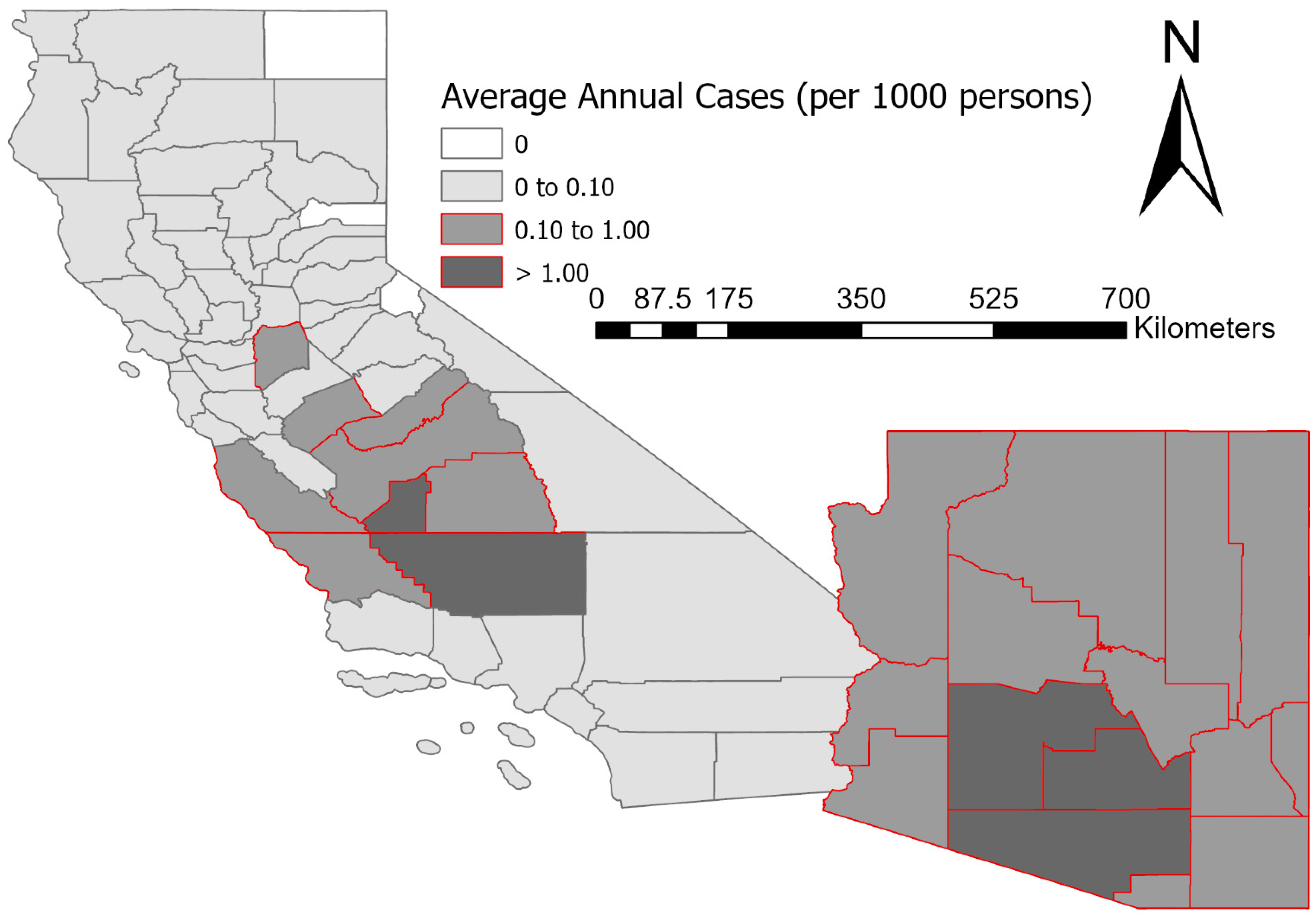
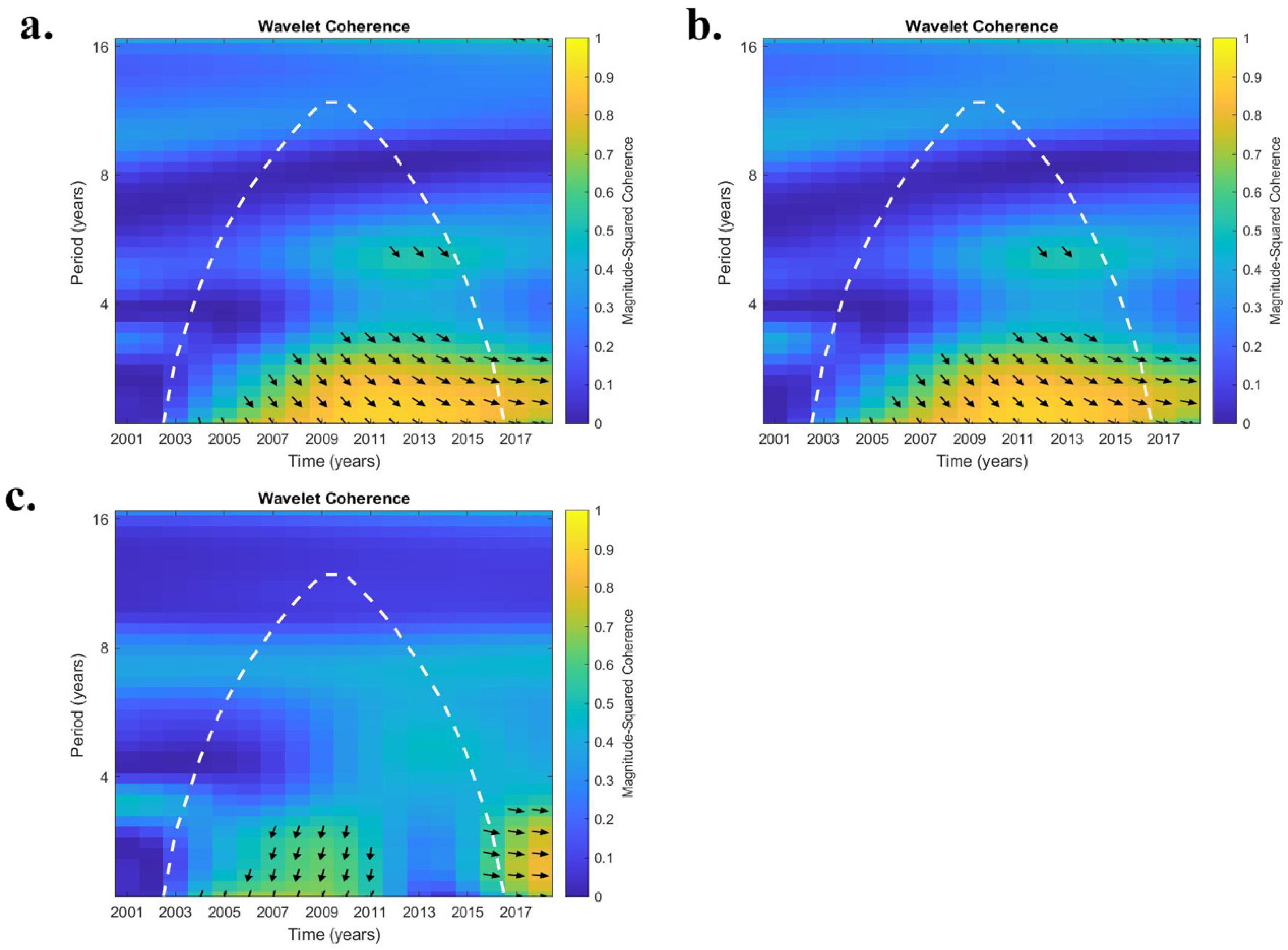
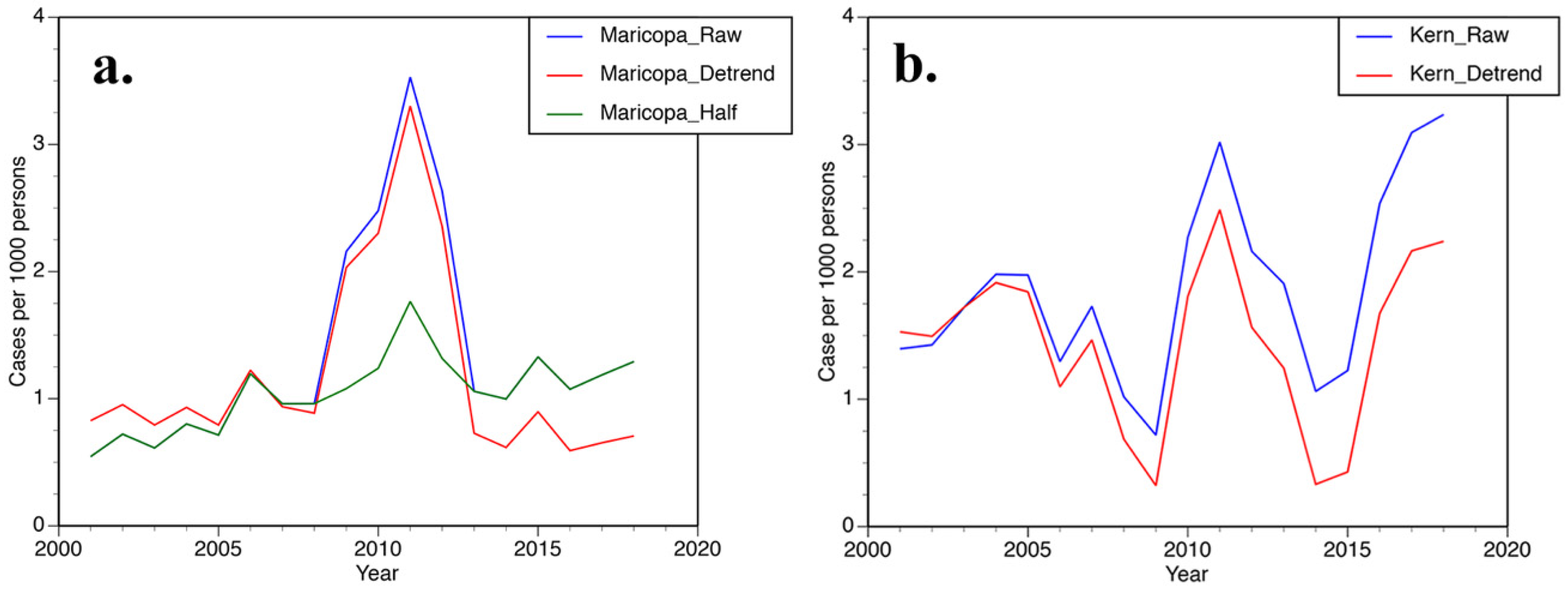
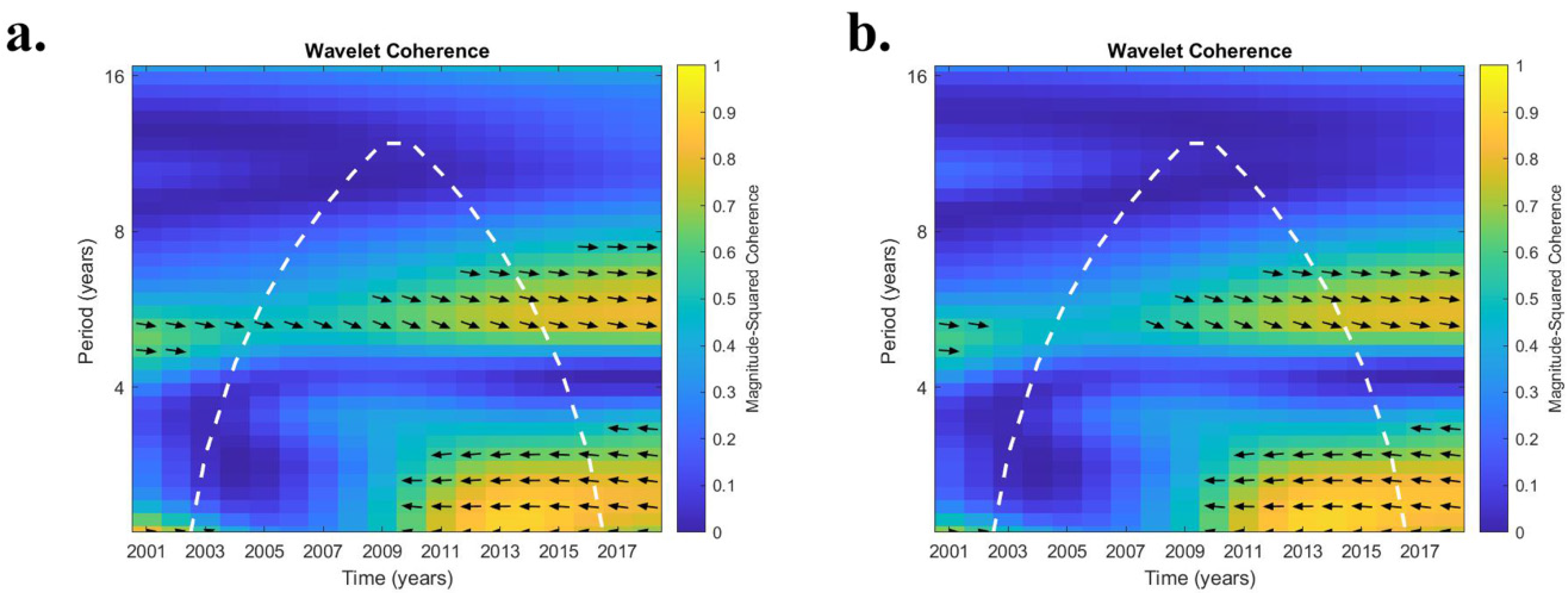
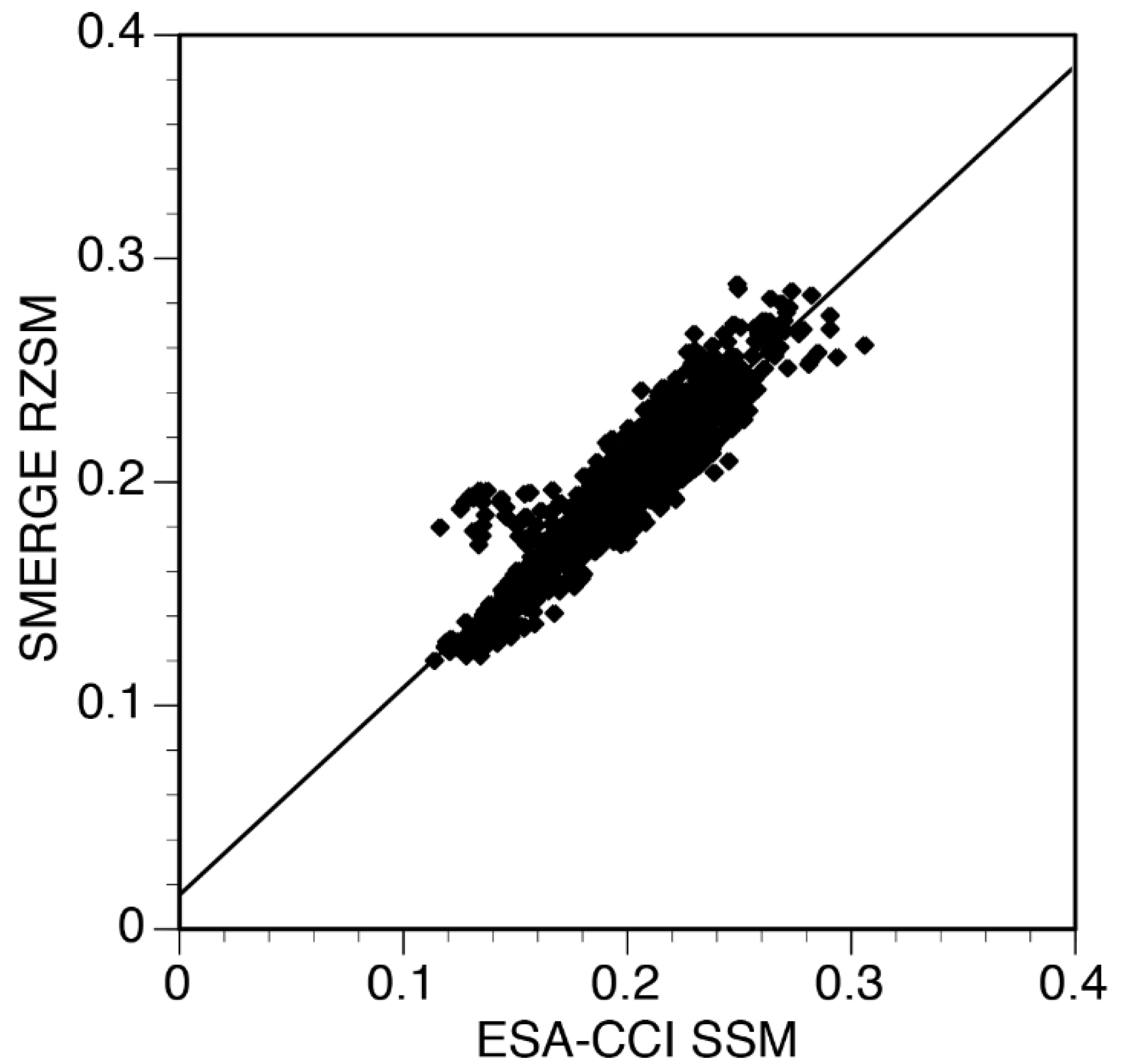
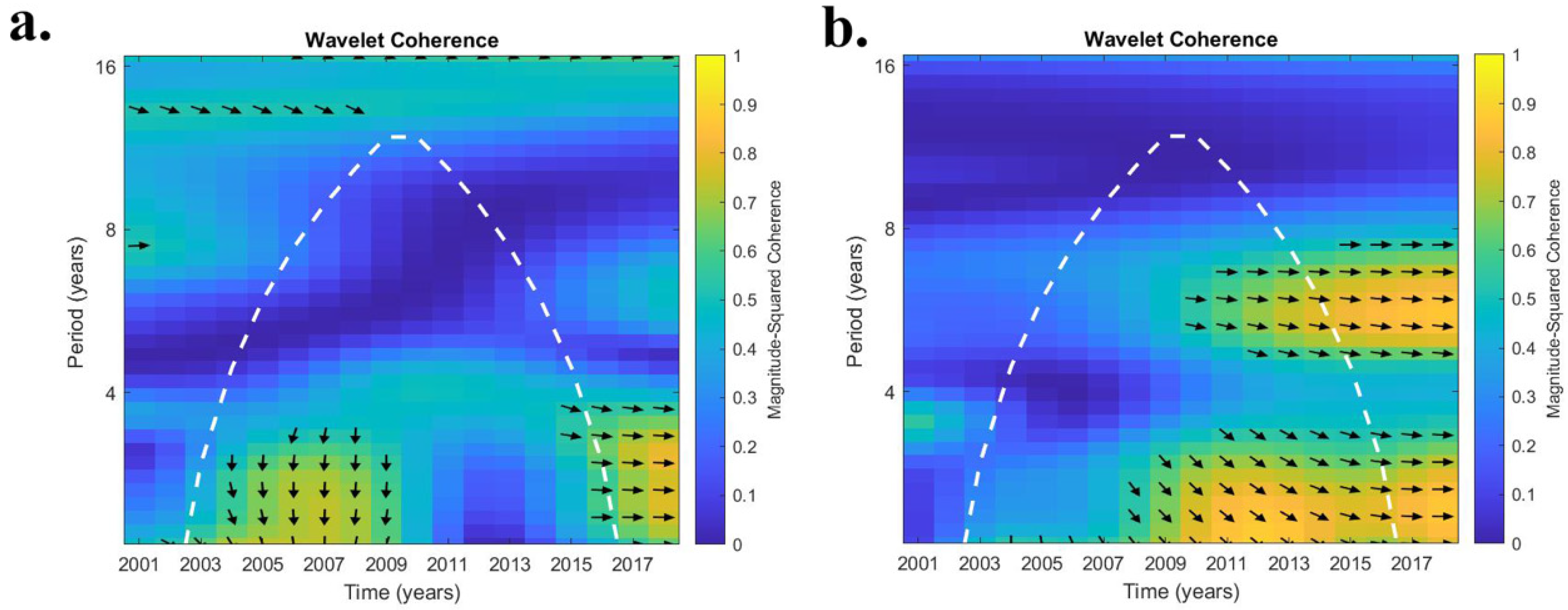
| Periodicity (Years) | Early Era (Start) | Late Era (End) |
|---|---|---|
| 2.1 | 2002 | 2017 |
| 3.0 | 2003 | 2016 |
| 4.0 | 2004 | 2015 |
| 5.0 | 2005 | 2014 |
| 5.9 | 2005 | 2014 |
| 7.0 | 2006 | 2013 |
| Raw Cases | Detrended Cases | Half Cases | ||||||||
|---|---|---|---|---|---|---|---|---|---|---|
| Location | Perd. (yrs) | Start to 2009 | 2010 to 2012 | 2013 to End | Start to 2009 | 2010 to 2012 | 2013 to End | Start to 2009 | 2010 to 2012 | 2013 to End |
| Maricopa | 2.1 | 0.587 | 0.897 | 0.832 | 0.606 | 0.897 | 0.814 | 0.525 | 0.516 | |
| Pima | 2.1 | 0.778 | 0.704 | 0.533 | 0.793 | 0.702 | 0.509 | |||
| Pinal | 2.1 | 0.780 | 0.871 | 0.775 | 0.786 | 0.870 | 0.748 | 0.674 | ||
| Avg AZ | 2.1 | 0.502 | 0.543 | 0.542 | ||||||
| Maricopa | 3.0 | 0.709 | 0.666 | 0.707 | 0.653 | |||||
| Pima | 3.0 | 0.648 | 0.678 | 0.644 | 0.660 | |||||
| Pinal | 3.0 | 0.569 | 0.762 | 0.736 | 0.549 | 0.759 | 0.717 | 0.566 | ||
| Avg AZ | 3.0 | None | ||||||||
| Pinal | 4.0 | 0.523 | 0.503 | |||||||
| Avg AZ | 4.0 | None | ||||||||
| Maricopa | 5.0 | 0.519 | 0.507 | |||||||
| Pinal | 5.0 | 0.519 | ||||||||
| Avg AZ | 5.0 | None | ||||||||
| All | 5.9 | None | ||||||||
| All | 7.0 | None | ||||||||
| Raw Cases | Detrended Cases | ||||||
|---|---|---|---|---|---|---|---|
| Location | Perd. (yrs) | Start to 2009 | 2010 to 2012 | 2013 to End | Start to 2009 | 2010 to 2012 | 2013 to End |
| Kern | 2.1 | 0.746 | 0.831 | 0.745 | 0.857 | ||
| Kings | 2.1 | 0.554 | 0.608 | ||||
| Avg Central CA | 2.1 | 0.588 | 0.659 | 0.514 | |||
| Kern | 3.0 | 0.543 | 0.646 | 0.542 | 0.649 | ||
| Avg Central CA | 3.0 | None | |||||
| All | 4.0 | None | |||||
| Kern | 5.0 | 0.561 | 0.624 | 0.551 | 0.616 | ||
| Avg Central CA | 5.0 | None | |||||
| Kern | 5.9 | 0.625 | 0.714 | 0.603 | 0.698 | ||
| Avg Central CA | 5.9 | 0.515 | 0.529 | ||||
| Kern | 7.0 | 0.504 | |||||
| Avg Central CA | 7.0 | 0.532 | 0.505 | ||||
| SSM ESA-CCI | RZSM SMERGE | ||||||
|---|---|---|---|---|---|---|---|
| Location | Perd. (yrs) | Start to 2009 | 2010 to 2012 | 2013 to End | Start to 2009 | 2010 to 2012 | 2013 to End |
| Maricopa | 2.1 | 0.516 | 0.656 | ||||
| Pima | 2.1 | 0.683 | 0.719 | ||||
| Pinal | 2.1 | 0.699 | 0.765 | ||||
| Avg AZ | 2.1 | 0.582 | 0.751 | ||||
| Avg AZ | 3.0 | None | |||||
| Avg AZ | 4.0 | None | |||||
| Avg AZ | 5.0 | None | |||||
| Avg AZ | 5.9 | None | |||||
| Maricopa | 7.0 | 0.765 | 0.720 | 0.706 | 0.574 | 0.505 | |
| Pima | 7.0 | 0.539 | |||||
| Pinal | 7.0 | 0.522 | |||||
| Avg AZ | 7.0 | None | |||||
| SSM ESA-CCI | RZSM SMERGE | ||||||
|---|---|---|---|---|---|---|---|
| Location | Perd. (yrs) | Start to 2009 | 2010 to 2012 | 2013 to End | Start to 2009 | 2010 to 2012 | 2013 to End |
| Kern | 2.1 | 0.520 | 0.848 | 0.767 | |||
| Kings | 2.1 | 0.543 | 0.968 | 0.900 | 0.641 | ||
| Avg Central CA | 2.1 | 0.591 | 0.600 | ||||
| Kern | 3.0 | 0.683 | 0.650 | ||||
| Kings | 3.0 | 0.748 | 0.789 | ||||
| Avg Central CA | 3.0 | None | |||||
| Avg Central CA | 4.0 | None | |||||
| Kern | 5.0 | 0.548 | 0.698 | 0.564 | 0.664 | ||
| Kings | 5.0 | 0.573 | 0.732 | 0.549 | 0.677 | ||
| Avg Central CA | 5.0 | 0.633 | 0.508 | 0.611 | |||
| Kern | 5.9 | 0.608 | 0.746 | 0.610 | 0.739 | 0.820 | |
| Kings | 5.9 | 0.695 | 0.831 | 0.621 | 0.769 | 0.856 | |
| Avg Central CA | 5.9 | 0.605 | 0.756 | 0.636 | 0.755 | 0.836 | |
| Kern | 7.0 | 0.554 | 0.518 | 0.584 | 0.636 | ||
| Kings | 7.0 | 0.524 | 0.610 | 0.665 | 0.582 | 0.631 | 0.675 |
| Avg Central CA | 7.0 | 0.548 | 0.614 | 0.589 | 0.643 | 0.690 | |
Publisher’s Note: MDPI stays neutral with regard to jurisdictional claims in published maps and institutional affiliations. |
© 2022 by the authors. Licensee MDPI, Basel, Switzerland. This article is an open access article distributed under the terms and conditions of the Creative Commons Attribution (CC BY) license (https://creativecommons.org/licenses/by/4.0/).
Share and Cite
Tobin, K.J.; Pokharel, S.; Bennett, M.E. Coccidioidomycosis (Valley Fever), Soil Moisture, and El Nino Southern Oscillation in California and Arizona. Int. J. Environ. Res. Public Health 2022, 19, 7262. https://doi.org/10.3390/ijerph19127262
Tobin KJ, Pokharel S, Bennett ME. Coccidioidomycosis (Valley Fever), Soil Moisture, and El Nino Southern Oscillation in California and Arizona. International Journal of Environmental Research and Public Health. 2022; 19(12):7262. https://doi.org/10.3390/ijerph19127262
Chicago/Turabian StyleTobin, Kenneth J., Sugam Pokharel, and Marvin E. Bennett. 2022. "Coccidioidomycosis (Valley Fever), Soil Moisture, and El Nino Southern Oscillation in California and Arizona" International Journal of Environmental Research and Public Health 19, no. 12: 7262. https://doi.org/10.3390/ijerph19127262
APA StyleTobin, K. J., Pokharel, S., & Bennett, M. E. (2022). Coccidioidomycosis (Valley Fever), Soil Moisture, and El Nino Southern Oscillation in California and Arizona. International Journal of Environmental Research and Public Health, 19(12), 7262. https://doi.org/10.3390/ijerph19127262






